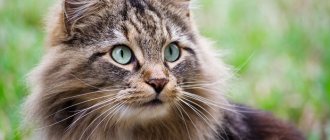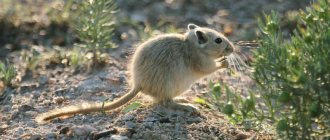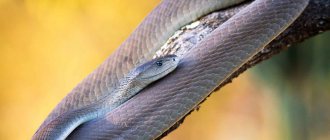Description
Jaguar (Panthera onca)
In appearance, jaguars resemble leopards, but they are much larger in size.
The body length is from 112 to 185 cm, the tail length is 45-75 cm, the weight ranges from 36 to 113 kg, the average is 60-90 kg, and the maximum figure recorded in nature was 158 kg. Height at the withers is from 63 to 76 cm. Females are always smaller and lighter.
Dimensions and appearance
The jaguar is a powerful and muscular animal. Outwardly it resembles a leopard, but it is much larger in size, has a stockier build and powerful limbs. On average, the predator weighs about 56-96 kg. The largest males can reach a weight of 158 kg, while the smallest females weigh only 36 kg. Males are larger and heavier than females by about 10-20%. The size of the predator varies widely depending on its habitat: the further south the animal lives, the larger it is. Jaguars in central Mexico are relatively small, weighing on average no more than 50 kg. Animals in Venezuela and Brazil are much larger: males weigh on average about 95 kg, females - from 56 to 78 kg.
The length of the body from the nose to the base of the tail is on average 1.1-1.8 m. The jaguar has the shortest tail of all big cats, only 45 to 70 cm long. The paws are short, but powerful and massive. Compared to a tiger or lion, the jaguar's limbs are much shorter for a comparable body weight. The height of the animal at the withers is on average from 63 to 76 cm. Powerful short legs allow the predator to swim, climb and crawl well. The jaguar has a large head, a strong skull and very powerful jaws - in terms of bite force, of all cats, it is second only to the tiger and the lion.
The color of the animal is predominantly dark yellow, there are also reddish and brownish shades. The fur on the belly is white, light yellow or light gray. Black jaguars, also called black panthers, are less common than common yellow spotted jaguars because the black gene is recessive. White jaguars (albinos) are born very rarely.
The animal's skin is covered with dark spots in the shape of rosettes, which help the predator to successfully camouflage itself when hunting. The size of the spots and their shape vary significantly. The spots on the head, neck and tail are usually continuous. On the back and sides there are large ring-shaped rosettes with a small spot in the middle. Animals that live in the forest are usually much darker and smaller in size than their counterparts that live in open spaces. This is explained by the fact that there are fewer large prey in the forest.
What does it eat?
— Advertising —
Jaguar food
The jaguar is a typical predator whose diet consists of approximately 87 species of animals. Among its favorite prey are capybaras and caiman. Jaguars also hunt deer, anteater, tapir, snakes (including anacondas), waterfowl and fish. Its prey can include monkeys, foxes, iguanas, opossums, otters, rodents, moths, freshwater turtles and armadillos. On the coasts, jaguars look for sea turtle eggs or attack females during laying. Jaguars can also hunt domestic animals, for example, cattle.
Economic significance for humans
Positive
Jaguars are predators and key species in the ecosystems they inhabit. Their skins and furs are sold for profit, despite the ban on hunting in most countries. Enforcement of laws protecting jaguars has improved in recent years. Jaguars are also an important source of income in ecotourism for local communities where there are opportunities to observe them.
Negative
Jaguars sometimes prey on cattle and other farm animals, leading to persecution by herders. Some countries, such as Brazil, Costa Rica, Guatemala, Mexico and Peru, have not banned hunting only for “problem” jaguars that repeatedly kill livestock. Bolivia allows trophy hunting of jaguars. Jaguars do not attack people without provocation.
Where does it live?
The jaguar's habitat begins in Central America and extends to Mexico and northern Argentina. The largest individuals were observed in Brazil. But in the territory of El Salvador and Uruguay, these predators were completely exterminated. In general, the modern range of jaguars has become one third smaller than the original one.
Where do jaguars live?
— Advertising —
The main places of their life are tropical rain forests and grasslands, as well as mountain forests, at altitudes up to 2000 m above sea level, and ocean coasts.
Common types
Types of jaguar
According to various sources, there are from 3 to 9 subspecies of jaguar, depending on their places of distribution, namely:
Panthera onca onca (Amazonian jaguar)
Panthera onca onca (Amazonian jaguars)
Live in the Amazon rainforests and are the nominate subspecies;
Panthera onca peruvianus (Peruvian jaguar)
Panthera onca peruvianus (Peruvian jaguar)
Residents of Peru and Ecuador;
Panthera onca hernandesii (Mexican jaguar)
Panthera onca hernandesii (Mexican jaguar)
Found in Mexico;
Panthera onca arizonensis (Arizona jaguar)
Panthera onca arizonensis (Arizona jaguar)
Distributed from southern Arizona to Sonora in Mexico;
Panthera onca centralis (Central American jaguar)
Panthera onca centralis (Central American jaguar)
Inhabitants of Central America;
Panthera onca goldmani (Goldman's jaguar)
Panthera onca goldmani (Goldman's jaguar)
Their habitat is Mexico, Belize and Guatemala;
Panthera onca veracrucis (Texas jaguars)
Panthera onca veracrucis (Texas jaguar)
Formerly native to central Texas, now extirpated;
Panthera onca palustris (Brazilian jaguar)
Panthera onca palustris (Brazilian jaguar)
Residents of southern Brazil;
Panthera onca paraguensis (Paraguayan jaguar)
Panthera onca paraguensis (Paraguayan jaguar)
Inhabitants of Paraguay;
Behavior
Jaguar behavior
Jaguars lead a solitary lifestyle. Like other cats of prey, they are territorial animals, and each individual occupies from 25 km2 (for females) to 50 km2 or more (for males). The hunting grounds of males are usually triangular, and their area allows the animal to move to a new piece every 3-4 days in search of prey. The jaguar visits its border points approximately once every two weeks. Therefore, this predator is often called a vagabond who wanders around the jungle. Jaguars are very intolerant of other cats (for example, pumas) in their territories, but are peaceful towards their relatives.
Origin of the species and description
Photo: Jaguar
The jaguar is a predator belonging to the genus panther and the subfamily of big cats. He is the only representative of his kind of panther, which settled in both North and South America. The appearance of a jaguar is very similar to leopards, but the former is much larger.
In different areas of its habitat, this predator is called by different names. For example, Latin Americans call him a tiger, although they are very distant relatives. The word “jaguar” itself means “blood” in the language of the Quechua Indian people. It occurs quite often in various names and in all sorts of phrases. It is assumed that the word personifies predators. These Indians compared brave and courageous people to pumas and jaguars. There is a word identical in sound in the language of the Guarani Indians, it is translated as “a beast that kills with one leap.”
Video: Jaguar
If we talk about the origin of this species of cat, then there is some evidence based on paleontological methods, they indicate that the last ancestor of this family, also a close relative of the clouded leopard, lived between six and ten million years ago.
Paleontologists suggest that the appearance of the species itself occurred about 3.8 million years ago.
Different scientists have different opinions about the jaguar's closest relatives; research into the animal's DNA continues to this day. Still, important morphological features indicate that the leopard is most closely related to the jaguar. The found remains of the extinct Barbary lion and the European jaguar, which belonged to the genus panther, indicate that these animals had the characteristics of both the lion and the jaguar.
Another molecular analysis done by scientists revealed that the modern species of jaguars appeared much later than excavation data indicate, this happened from 510 to 280 thousand years ago. There is still a lot of mystery and incomprehensibility in the origin of the modern jaguar that lives today, so scientists’ research does not stop today.
Hunting
Jaguar on the hunt
Jaguar is a crepuscular predator. Actively hunts after sunset and before dawn. Its main method of hunting is ambush in trees or among tall grass. Usually the animal arranges it on the banks of a reservoir. When attacking a prey, a jaguar jumps on it from the back or side, grabs it by the neck, trying to throw it to the ground, which usually leads to instant death. If the prey detects a predator and runs away, jaguars usually do not pursue it. The jaguar can divide the hunted large animal into two meals, but no more; it does not feed on carrion.
Jaguar hunting
When hunting, jaguars make low, abrupt, guttural sounds, and at night and during the mating season they roar deafeningly.
Habits
There are very few known cases of this predator attacking people, and more often this was provoked by the person himself. Scientists (naturalists, zoologists) and travelers believe that the predator is simply curious and not aggressive.
In essence, the black jaguar is a free cat that loves wild spaces.
Quite readily attacks domestic livestock. The peculiarity of the jaguar is that it does not pursue fleeing animals.
He loves to dig up turtle eggs, and can also deal with the turtles themselves, removing their soft parts from under the shell with his paw. He simply crushes smaller individuals with his teeth. In addition, this predator is an excellent swimmer and a good fisherman.
As a rule, it eats its prey, starting from the head. It almost never eats carrion.
When hunting, the jaguar makes unusual sounds - a guttural, abrupt grunt, and during the mating season and at night it makes a loud roar.
Reproduction
Reproduction of jaguars
There is no clearly defined mating season in jaguars. But at this time, single animals gather in small groups. Fights between males practically do not occur, and the female chooses her partner. When she makes her choice, she comes to the male’s site, where she remains only for the duration of mating.
Pregnancy
Pregnant female jaguar
Pregnancy lasts about 100 days, after which the female goes into a den, hidden from prying eyes among stones, in a dense bush or hollow, and 2-4 babies are born.
Offspring
Offspring of a jaguar
Cubs are distinguished by the presence of many large black spots in their color. They remain in the den for the first 6 weeks of life, and then hunt with their mother until they reach sexual maturity and search for their own personal area.
Puberty
Sexual maturity of the jaguar
The female becomes sexually mature at the age of 3 years, the male - a little later. In captivity, jaguars live from 22 to 25 years.
Jaguar lifestyle and nutrition
Outside the breeding season, the jaguar leads a solitary lifestyle. The area of the site ranges from 25 to 170 km2. The size of the hunting area depends on the landscape, the abundance of prey and the sex of the animal. The hunting grounds of jaguars often overlap. In this case, the jaguar is peaceful towards other jaguars, but it is hostile towards other cats in its territory, for example, pumas. The male's hunting area is usually triangular in shape. The jaguar hunts for 3/4 of the day in one part of its territory, then moves to another area. In addition, the jaguar visits “border points” approximately once a week. We can say that jaguars are vagabonds traveling through the jungle.
The jaguar is active at any time of the day. But he prefers to hunt at dusk and at night. His most active hunting times are after sunset (from approximately 18:31 to 21:31) and before dawn (from 03:01 to 06:01). Most often, the jaguar hunts from an ambush, which it arranges on the banks of water bodies, in tall grass, in trees or on paths leading to a watering hole. When attacking a victim, it jumps on its back, trying to knock it down. The victim is grabbed by the neck. A jaguar's bite is so strong that it can bite through a cow's skull. The jaguar is able to cope with prey that weighs up to 300 kg. It hunts fish from the shore, throwing them out of the water with blows of its powerful paws. Hunts for monkeys in trees or near watering holes. The jaguar never pursues the victim if it starts to run away. It begins to eat prey from the head, gradually moving towards the back. If the prey is large, the jaguar remains near it for some time. He does not eat carrion.
The jaguar's main prey is capybaras (see video of a jaguar hunting a copybara) and other representatives of ungulates, such as mazami deer, peccaries and tapirs. But it also feeds on other large and small vertebrates: birds, alligators, caimans (by the way, look: a jaguar caught a caiman), large rodents, fish, primates, wild pigs. One of the jaguar's prey is sea turtles; the strength of its jaws allows our predator to bite through their shell. The jaguar willingly attacks livestock, this is how it differs from the puma. If the prey tries to escape in the water, the jaguar overtakes it quite easily. The jaguar, like the tiger, is an excellent swimmer. He can also dig turtle eggs out of the sand on the ocean shore, and sometimes snatches passing fish from the water.
There are very few known cases of jaguar attacks on people, and even fewer attacks unprovoked by people. Cannibalism among these predators is an exceptional phenomenon. Most often, a jaguar attacks a person when defending itself. If not provoked, the jaguar is usually not aggressive, but rather curious and often chases a person through the forest without showing hostile intentions, but occasionally attacks people.
People who unexpectedly met a jaguar in the forest experienced a strange mixed feeling of respect and surprise. In this regard, Brazilian hunters attribute the ability to hypnotize to the jaguar.
Threats
In many regions of their former distribution, jaguars were completely exterminated. This is due both to changes in the natural habitats of animals, and to fishing for the purpose of extracting their valuable skins, and to shooting by pastoralists who feared for their herds.
Jaguar in the reserve
Today, jaguars are included in the International Red Book and are protected in many countries. Limited shooting is permitted in Brazil, Mexico and Bolivia.
Interesting facts about the jaguar:
Interesting facts about the jaguar
- Jaguars rarely attack people, and will never do so unless provoked. These predators are not aggressive, but rather curious, often chasing people through the forest, without any hostile intentions.
- The American aborigines greatly respected and valued the jaguar, as one of the most powerful predators on the continent. Among the Olmecs, the predator was the main cult hero and occupied a central place in the pantheon of gods. The Mayans also revered jaguars, and chiefs wore their skins and helmets shaped like their heads as symbols of supreme power.
- According to Indian legends, jaguars are able to imitate the cries of any birds and animals in order to lure them. Brazilian hunters credited jaguars with the ability to hypnotize their victims.
- The name "Jaguar" is borne by an automobile company known for producing high-end sports cars.
Interesting Facts
Many ancient American cultures, such as the Mayans and Aztecs, featured the Jaguar in their mythologies. In pre-Columbian Central and South America, the beast was a symbol of strength and power.
The Argentina national rugby team badge includes an image of a Jaguar. However, a historical mistake led to the team being nicknamed Los Pumas (puma) to this day.
Jaguars like to remain hidden when they sleep. They usually find an area that is surrounded by trees. The beast can even sleep in a tree. Jaguars also rest in areas of long grass.
The Jaguar can run at speeds of over 103 kilometers per hour, but only for short distances.
It is estimated that there are currently only about 15,000 Jaguars left in the wild, and their conservation is focused on creating protected national parks that can help reduce the predators' natural habitat. It is listed in Appendix I of CITES and is in danger of total extinction.
In some traditions, the Jaguar Night God was a fearsome lord of the underworld.
Jaguars see nearly seven times better than humans at night or in darker conditions thanks to a layer of tissue at the back of the eye that reflects light.
Jaguar
Jaguar
Jaguar
Jaguars often plunge their tails into the water to lure fish, like on a fishing line.
Jaguars are very popular in the modern world as an element of symbolism or a brand. These are the national animals of Guyana, depicted on its coat of arms, and the Jaguar is also the official animal of Brazil.
Jaguar is widely used as a product name, especially in the British luxury car brand.











